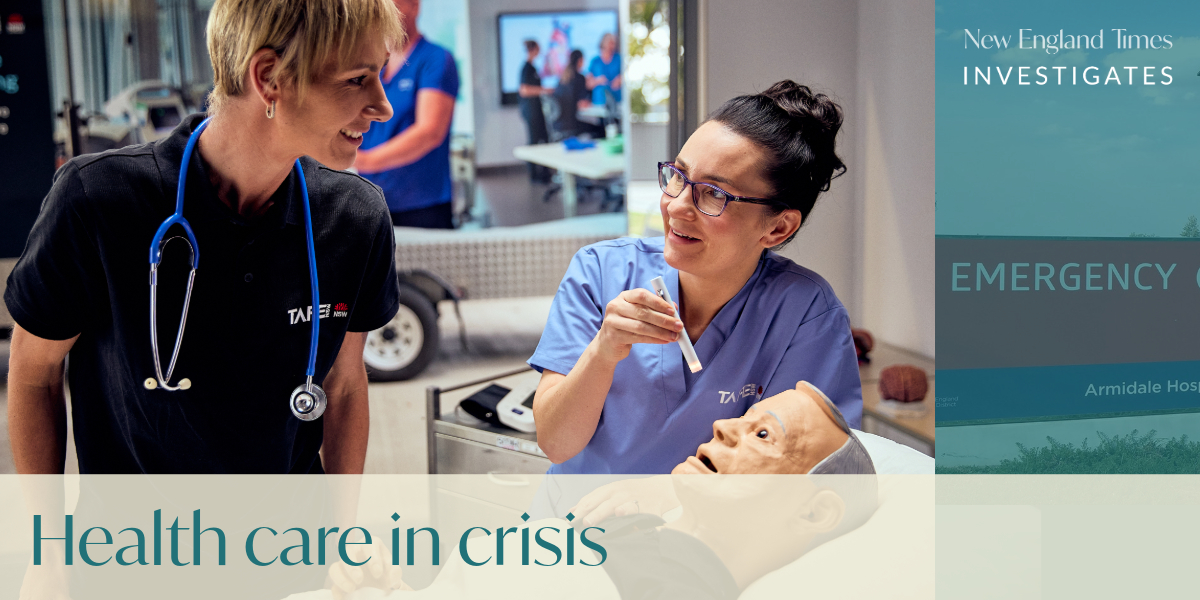
The critical shortage in health care services across the New England permeates through every level of staff and every service. Doctors, nurses, paramedics, allied health – even good health administrators are in demand. The lack of staff puts existing staff under pressure, only leading to more and more people leaving the sector, and the situation worsening.
In the face of this growing health care crisis, TAFE NSW is taking steps to ease the pressure on regional healthcare services through a progressive partnership with Inverell Hospital. The initiative, now in its third year, is providing Year 11 and 12 students with hands-on experience in healthcare while addressing critical staffing shortages.
The partnership aims to provide Year 11 and 12 students with real-world exposure to healthcare roles, offering them an 80-hour, hospital-based training program. Students, particularly those training as Health Service Assistants, shadow qualified nurses, gaining valuable skills and offering much-needed support to overburdened hospital staff.
As Australia’s largest employment sector, health care and social assistance continue to grow, but the sector faces dire shortages. Recent data reveals that four out of five health occupations are experiencing shortages, with an estimated shortfall of 123,000 nurses predicted by 2030. At Inverell Hospital, the staffing crisis is pressing, and local officials are welcoming the TAFE NSW program as an essential part of the solution.
“The partnership with TAFE NSW is a critical part of addressing the healthcare staffing issues in our region. By embedding students in the hospital environment, we are not only giving them the skills they need but providing invaluable support to our existing staff,” Katherine Randall, Health Service Manager at Inverell Hospital, said.
The immersive program ensures that students are not left to navigate the complexities of healthcare alone. The presence of TAFE NSW teachers, who provide real-time support, means that students receive guidance and feedback in the field, building their confidence and practical skills before they transition into the workforce.
“The real-time support from teachers ensures students are not just thrown into the deep end,” Randall said.
“They will leave the course confident and with first-hand experience of the realities of our line of work.”
The program also serves to create a pipeline of job-ready workers, easing the strain on a sector in desperate need of skilled staff. Students gain critical hands-on experience while still in school, ensuring they are better prepared to transition into the workforce once they complete their studies.
“This approach goes beyond training. It is about building a pipeline of job-ready healthcare workers still in school, ready to ease sector pressure as they transition into the workforce.”
Have your say on our health system in this week’s Engage Poll
For TAFE NSW nursing teacher Candace Destefani, the partnership has been a rewarding experience.
“Building the partnership is incredibly rewarding, because we see students grow from theory-based learners into confident and resilient healthcare professionals,” she said.
“As their teacher, I am proud to see them ready to face the challenges of working with patients and cross-disciplinary teams, with the support and skills they need to succeed.”
“Through innovative teaching, TAFE NSW is equipping students with the skills they need today, helping to fill crucial roles in tomorrow’s regional healthcare system,” Destefani said.
For students like Cathryn Skinner, who participated in the program as part of her Certificate III in Assistant in Nursing, the experience has been invaluable.
“It was very eye-opening. I don’t think you understand what nurses go through every day until you’re in that position,” Skinner said. “It was a very draining but so worth it in the end.”
Skinner, who has dreamed of becoming a nurse since kindergarten, said that the program confirmed her career choice.
“Being in the hospital just kind of set it in stone that I wanted to do this with my life,” she said.
Skinner found the experience fulfilling, saying that the work was demanding but ultimately rewarding.
“It was so worth it to see all of the patients get better and leave the hospital. It’s good practice for what it’s like in the end.”
Skinner will be taking a gap year to earn enough to be able to study, but has plans to begin her university studies to become a registered nurse in 2026, and says the program helped open that pathway for her.
“It definitely helped me get into uni. I don’t think I would have had so many options if I hadn’t done the program.”
This innovative approach to healthcare training is part of a broader effort to address the staffing crisis in regional NSW. The state has struggled with chronic public-sector nurse shortages since the Covid-19 pandemic, with NSW Health reporting a 12.6 per cent loss of its workforce in 2021-22.
In response, the NSW Labor government has implemented a range of initiatives to bolster staffing levels, including the $121.9 million Tertiary Health Study Subsidy Program, which offers new students $4,000 per year in exchange for a commitment to work in the NSW public health system for five years. The program also provides an $8,000 payment to existing nursing students who accept positions with NSW Health.
This article is part of a series on Health Care in Crisis. See our other stories on this topic here.
Like what you’re reading? Support New England Times by making a small contribution today and help us keep delivering local news paywall-free. Support now


